2006 VOLKSWAGEN GOLF child seat
[x] Cancel search: child seatPage 4 of 444
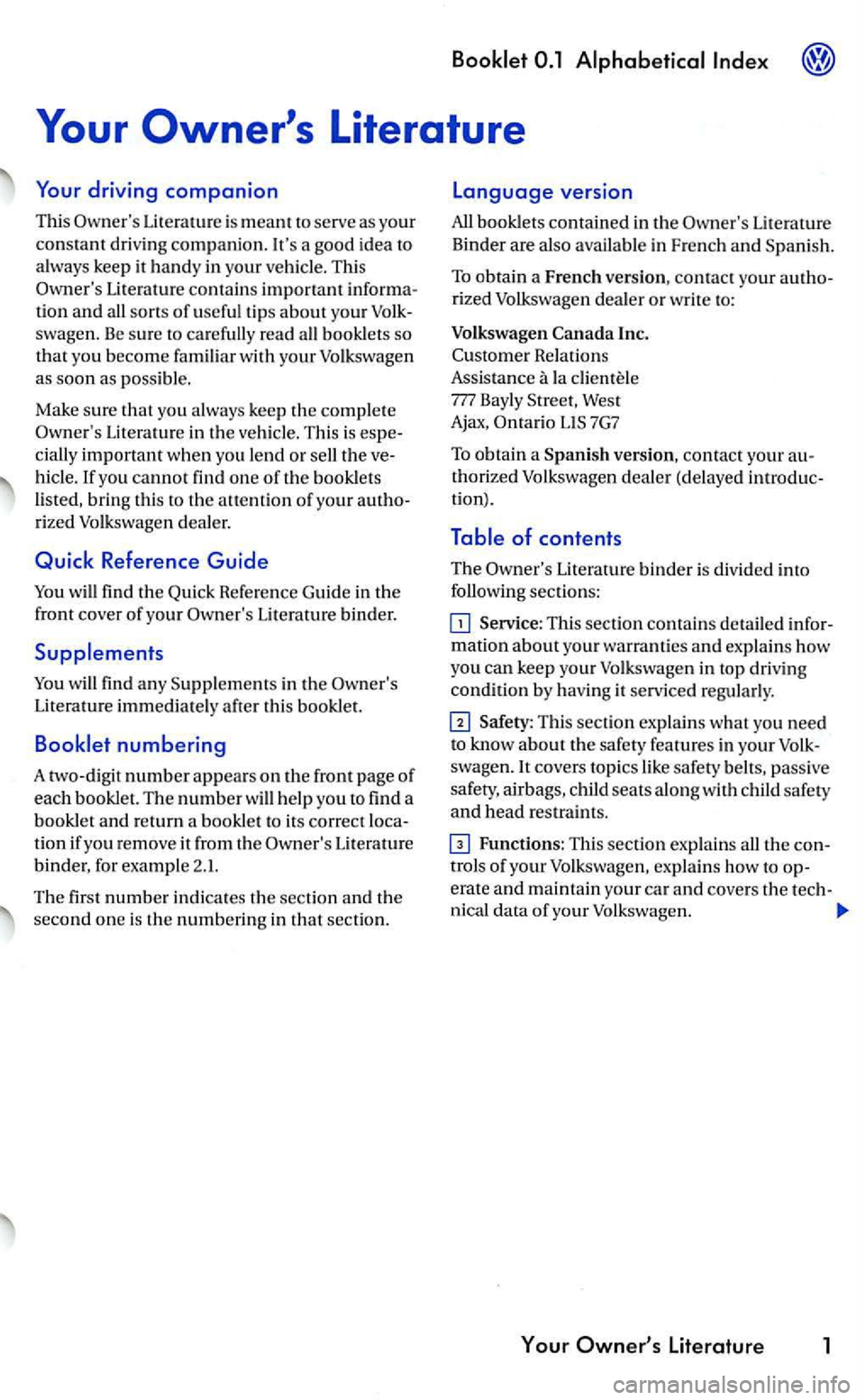
Your
a goo d idea to alway s keep it handy in your vehicle. This
Owner 's Literatur e contains important informa
t ion and all sorts of useful tip s abo ut your Volk
swage n. Be sur e to care full y rea d all bookle ts so
t hat yo u beco me familiar with your Volkswage n
a s soon as poss ible .
Ma ke s
ure that you always keep th e complete Owner's Literature in the ve hicle . T hi s is espe
cially important w hen you lend or sell the ve
hicle . you cannot find one of th e booklets lis ted, brin g thi s to the attent io n of your autho
r ize d Volkswagen dealer.
Quick Reference Guide
You find the Quick Reference Guid e in the
front cover of your Owner's Lite rature binde r.
You will find any Supplements in the Ow ner's Literature immediate ly afte r thi s booklet .
Ia cli ente le m Bayly W es t
A jax , Ontario 7G7
To obtain a versi on, contact your a u
thori zed Volkswagen dealer (d e layed introd uc
tion).
Service : This section contains detailed in for
mation about your warr anti es and explain s how you can keep your Volk s wa gen in top drivin g
co ndition by hav ing it serviced regularly.
covers topics like safe ty belt s, pass ive
safety, airb ags, child seats alo ng wit h child safety and head res tra ints .
Functio ns: This section exp lain s all th e con
trols of your Vol k swage n, ex pla in s how to op
erate and maint ain your car a nd cove rs th e tech-
nical data of your Volkswagen .
Page 9 of 444
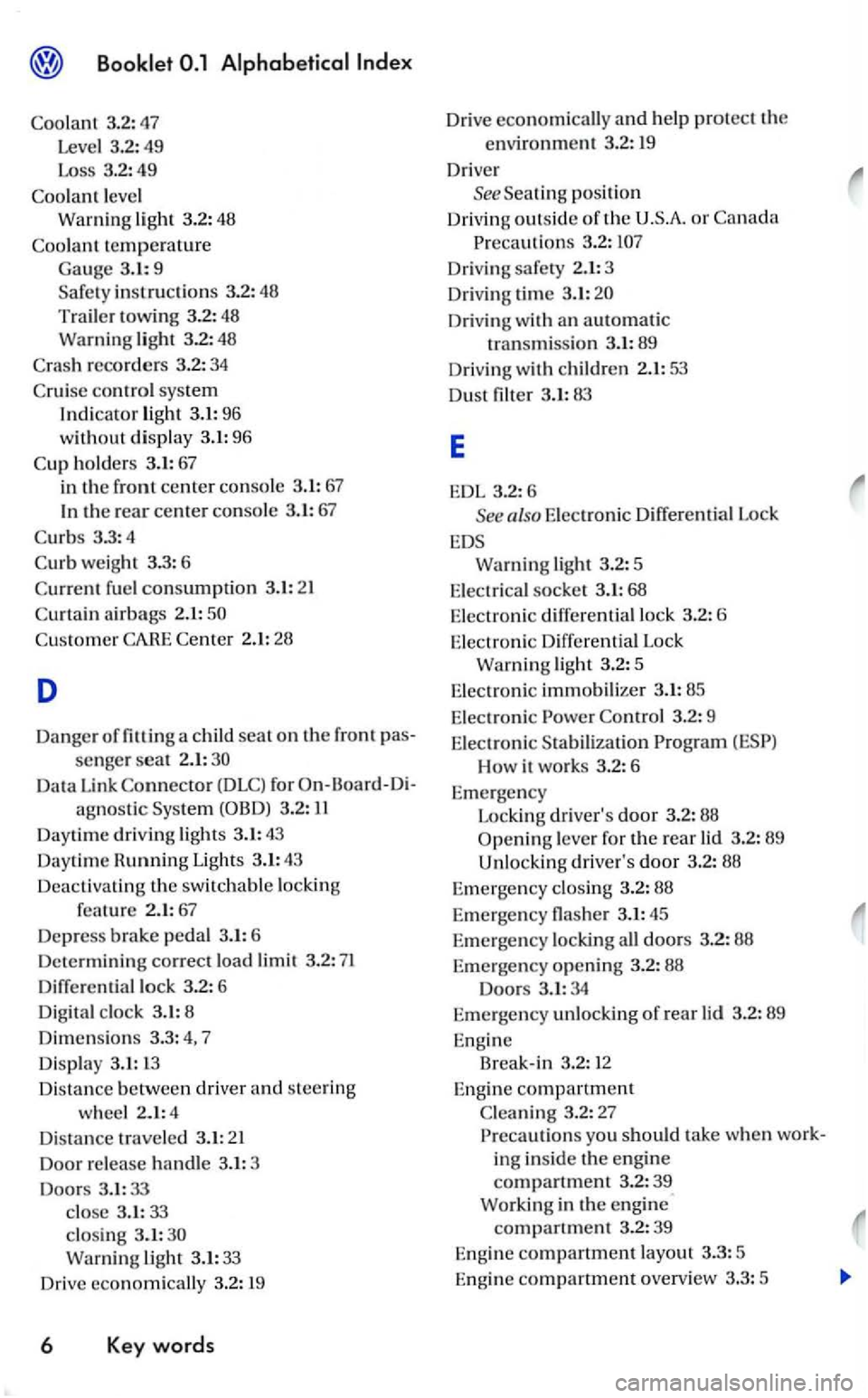
Coolant 3.2: 47
Level 3.2:
49
Loss 3.2:49
Coolant leve l
Warning light 3.2: 48
Coolant temperature
Gauge 3.1:9 Safe ty instru ctions 3.2:48
Trail er towing 3.2: 48
Warning light 3.2 : 4 8
C
ras h recorders 3.2: 34
C rui
se control system
Indicator light 3.1:96
without display 3.1: 96
C up ho ld ers 3.
1: 67
in the front center consol e 3 .1: 67
the rear center console 3.1:67
Curbs 3.3:4
Curb weight 3.3 : 6
C
urrent f u el con sumptio n 3.1:21
C
urtain airbags 2.1:
Custome r Center 2.1: 28
D
Danger of fittin g a child seat on the front pas
senger seat 2.1:
Daytime dri ving lights 3.1:4 3
Daytime Hunning Light s 3.1: 43
D
eactiv ating the switchabl e lockin g
2.1: 67
Depress brake ped al 3.1: 6
Determining correct load l im it 3.2: 71
Diff
erential lock 6
Digit al cl
ock 3.1:8
Dimensio n s 3.3: 4, 7
Disp la y 3.1: 1 3
D is t
ance b etween driver and steerin g
w h
eel 2.1:4
D is ta n
ce travele d 3.1: 21
Door re lease h andle 3.1: 3
Doors 3.1:33
close 3.1: 33 closing 3.1: Warning li gh t 3.1: 33
Drive economically 3.2: 19
6 Key words
Drive economic all y and he lp protect the
environment 3.2: 19
Driv er See Seating position
Drivin g outside of the
Driving safety 2.1: 3
Driving lime 3
.1:
E
EDL 3.2:6
See also Electronic Differ ential Lock
Warning light 3.2:5
Electrical socket 3.1: 68
E
lectronic diff ere nti al lock 3.2: 6
Electroni c Differential Lock
Warning light 3.2: 5
Ele c
tronic immobilizer 3.1:85
E l
ectronic Co ntrol 3.2: 9
E l
ectronic Stabilization
How it works 3.2: 6
Eme rge ncy
L
ockin g driver's door 3.2: 88
Opening l eve r for the rear lid 3.2: 89
Unl ocki ng
driver's door 3.2: 88
Em ergency closing 3.2: 88
E m er
gency nasher 3.1: 45
E m
ergency locki ng all doors 3.2: 88
Emergency ope nin g 3.2: 88 Doors 3.1: 34
Emer gency
unlocking of rear lid 3.2: 89
E ng
ine Break-in 3.2: 12
Eng in e compartment
Cleaning 3.2 :27 you should take when work
i
ng in sid e the e ngin e
compartment 3.2:39 Work ing in the engine
compartment 3.2: 39
E n g in e
compartment la yout 3.3 : 5
E n
gine compartment overview 3.3: 5
Page 14 of 444
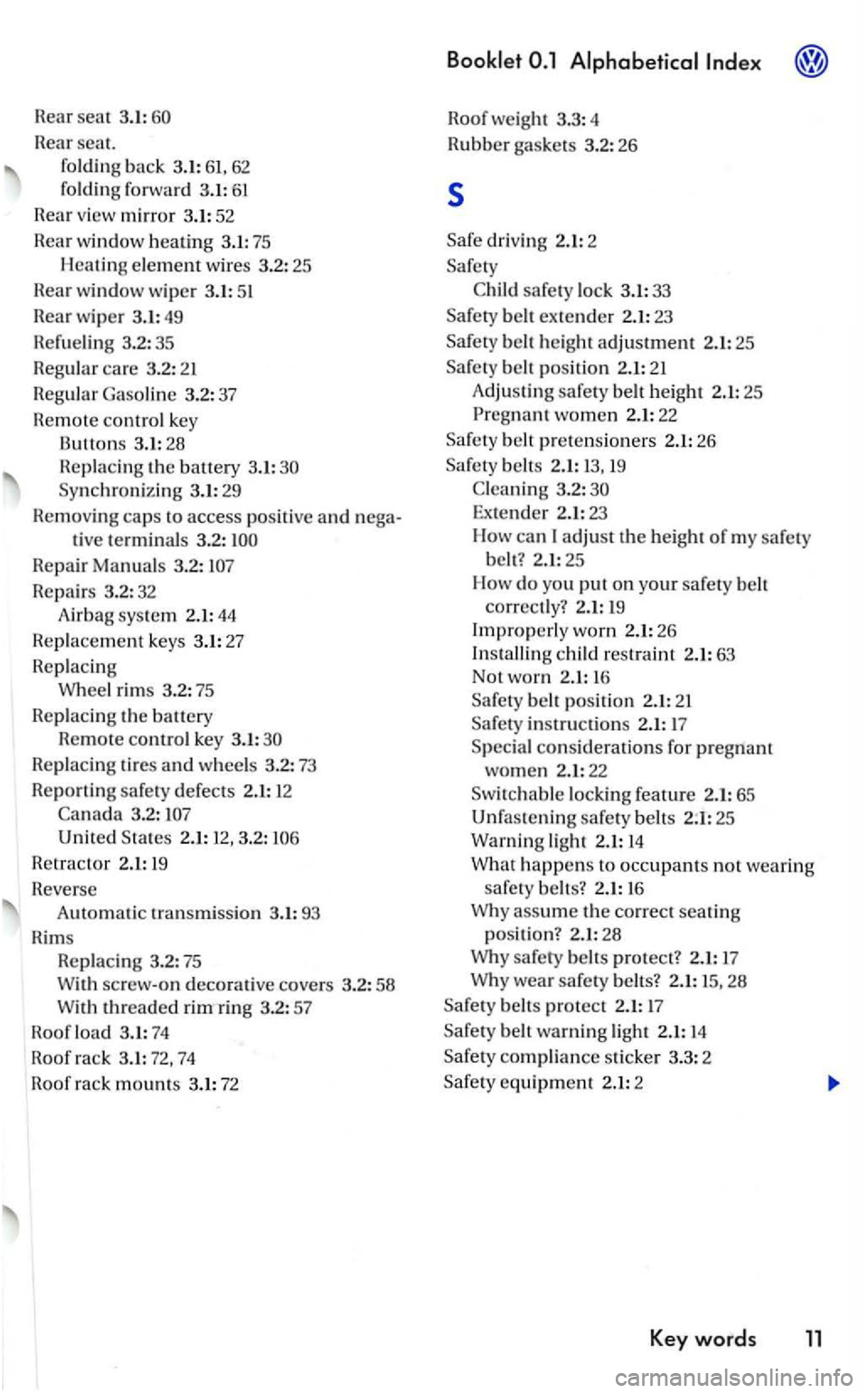
seat 3. 1:
seal.
foldin g back 3.1:61, 62
fold ing forward 3.1: 61
v iew mirror 3.1:52
window heating 3.1: 75
Heating wires 3.2:25
window wiper 3. 1:51
H
earwipe r 3.1:49
3.2: 35
care 3.2:2 1
contro l key tons 3.1: 2 8
Heplaci ng th e bauery 3.1: Synchroni zing 3.1: 29
H emoving caps to acce ss positiv e and tive te rminal s 3.2:
2.1: 12,3.2: 106
R etra ct
or 2.1: 19
R everse
A utomatic transm ission 3.1:93
Hims
R
epl aci ng 3.2: 75 With screw-on decorative cove rs 3.2: 58
With threaded rim ring 3.2:57
Hoof l
oad 3.1: 74
we ight 3.3: 4
Rubb er ga sket s 3.2:
26
s
driv in g 2.1: 2
Sa fety
C hild
safet y lock 3.1: 33
Sa fe ty belt ex te
nder 2.1:23
b elt height adjustment 2.1:25
belt pos ition 2.1:21
Adju sting safe ty
belt height 2.1:25
Pr eg nant
women 2.1: 22
Sa fe ty belt pre tension ers 2.1:26
Sa fety belt s
2.1: 13, 19
C leaning 3.2:
Extende r 2. 1: 23
Ho w ca n I adjust the height of my safety
belt? 2.1: 25
How
do yo u pu t on your safety belt correc tly? 2.1 : 19
Improp erly worn 2.1:26
child restraint 2.1:63
N ot
worn 2.1: 16
belt positi on 2.1: 2 1
instru ction s 2.1: 17
S p ec ial c
onsiderations for pregnant women 2.1: 22
Swi tc h able lo cking feature 2.1: 6 5
Unfa ste
ning s afety be lt s 2.1:2 5
Warning lig ht 2.1: 14
What happens to occ upants not wearing
safe ty be lts? 2.1: 16
Why assume
the correct seatin g
po sition ? 2.1:28
Why saf e ty belt s protect ? 2. 1: 1 7
Why wear safety belt
s? 2.1: 15, 28
Safe ty belts pro tect 2.1: 17
b elt warning ligh t 2.1: 14
Safety compliance sticke r 3.3: 2
Key words 11
Page 15 of 444
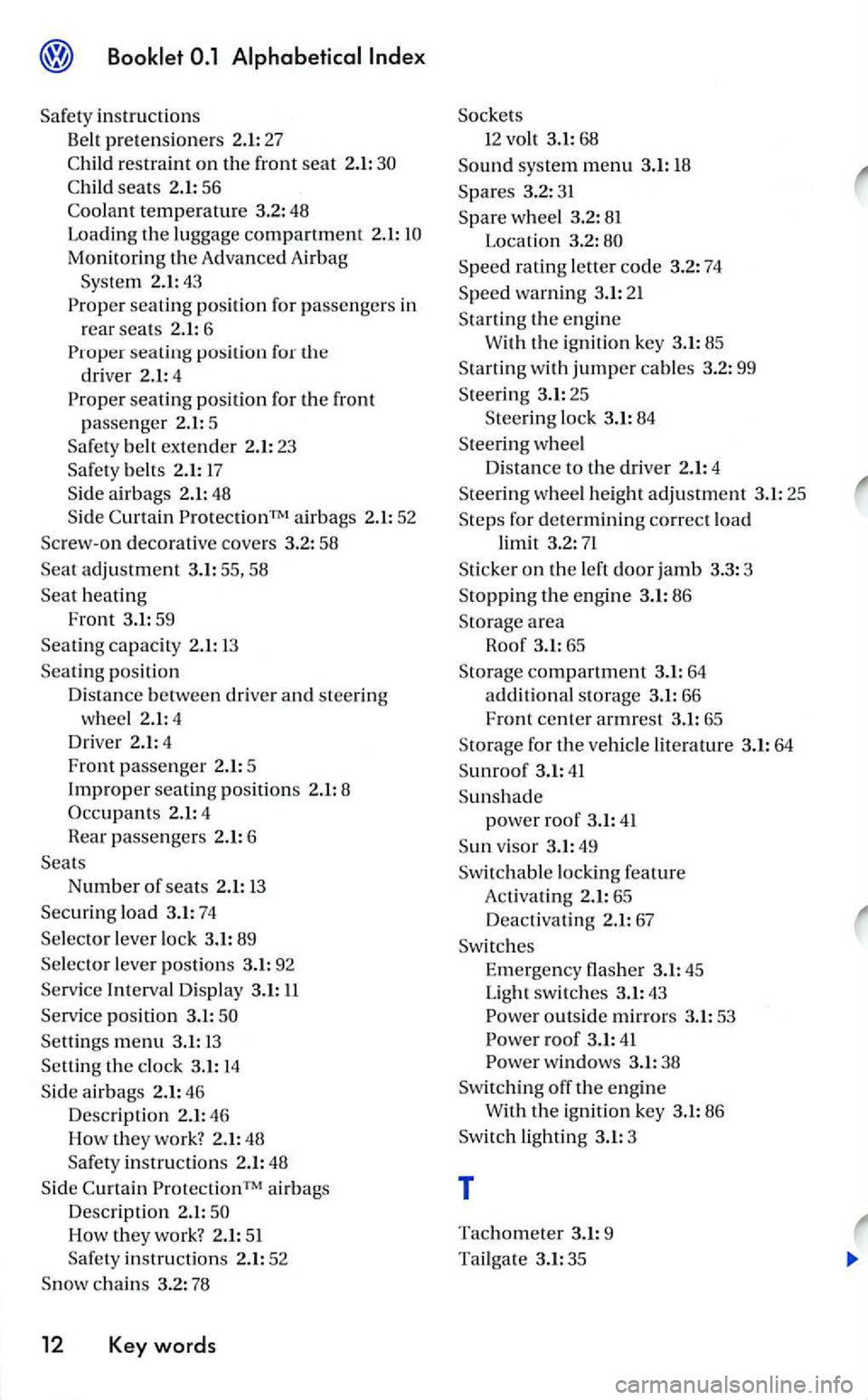
Safety instructions
Belt pretensioners 2.1: 27
Child restraint on the front seat 2.1:
Child seats 2.1 : 56
Coolant tempera ture 3.2:48
Loading
the lu ggage compartment 2.1:
seating position for passengers in
r
ear seat s 2.1: 6 seating position for
driver 2.1: 4
seating position for the front
passenger 2.1: 5
Safety belt extender 2.1: 23
Sa fet y
belts 2.1: 17 S id e airbag s 2.1: 48
Side Curtain ProtectionTM airbags 2.1: 52
Screw-on decorati ve covers 3.2: 58
Seat adjustment 3.1: 55, 58
Seat heating
Front 3.1:
59
Seating ca pacity 2.1: 13
Sea ting
position
Di s
tance between driver and ste erin g
w
hee l 2.1:4 Dr iver 2.1: 4
Fron t passen ger 2.1: 5 Improper seatin g position s 2.1: 8
Speed rating le tter code 3.2: 74
Speed warning 3.1: 21
Starting th e engine W ith the ig nition key 3.1:85
S tartin g
with jumper cables 3.2: 99
Stee rin g 3.1: 25
S
teering lock 3.1: 84
S te ering
wheel
Di s
tance to the driver 2.1: 4
Steerin g wheel height adjustment 3.1: 25
S
teps for determining co rrect load limit 3.2: 71
Sticker on th e left door jamb 3.3 : 3
Stopping the en gine 3.1:8 6
Sto rage
area
Roof 3.1:65
S torage
compartment 3.1: 64
additional sto rage 3.1: 66
Front center armrest 3.1: 65
S torage for
the vehicle literature 3.1: 64
Sunroof 3.1: 41
Sunshade
power roof 3.1:41
Sun viso r 3.1:49
Sw itch
able loc king feature
Activatin g 2.1: 65
D
eacti va tin g 2.1: 67
Sw itches Em ergency flasher 3.1: 45
Light swit ches 3.1: 43 outside mirrors 3.1: 53 ro of 3.1:41 windows 3.1: 38
Sw itching off the engin e
W ith the ignit ion key 3.1: 86
Sw itch
lig htin g 3.1: 3
T
Tachometer 3.1: 9
Ta
ilga te 3.1:35
Page 91 of 444
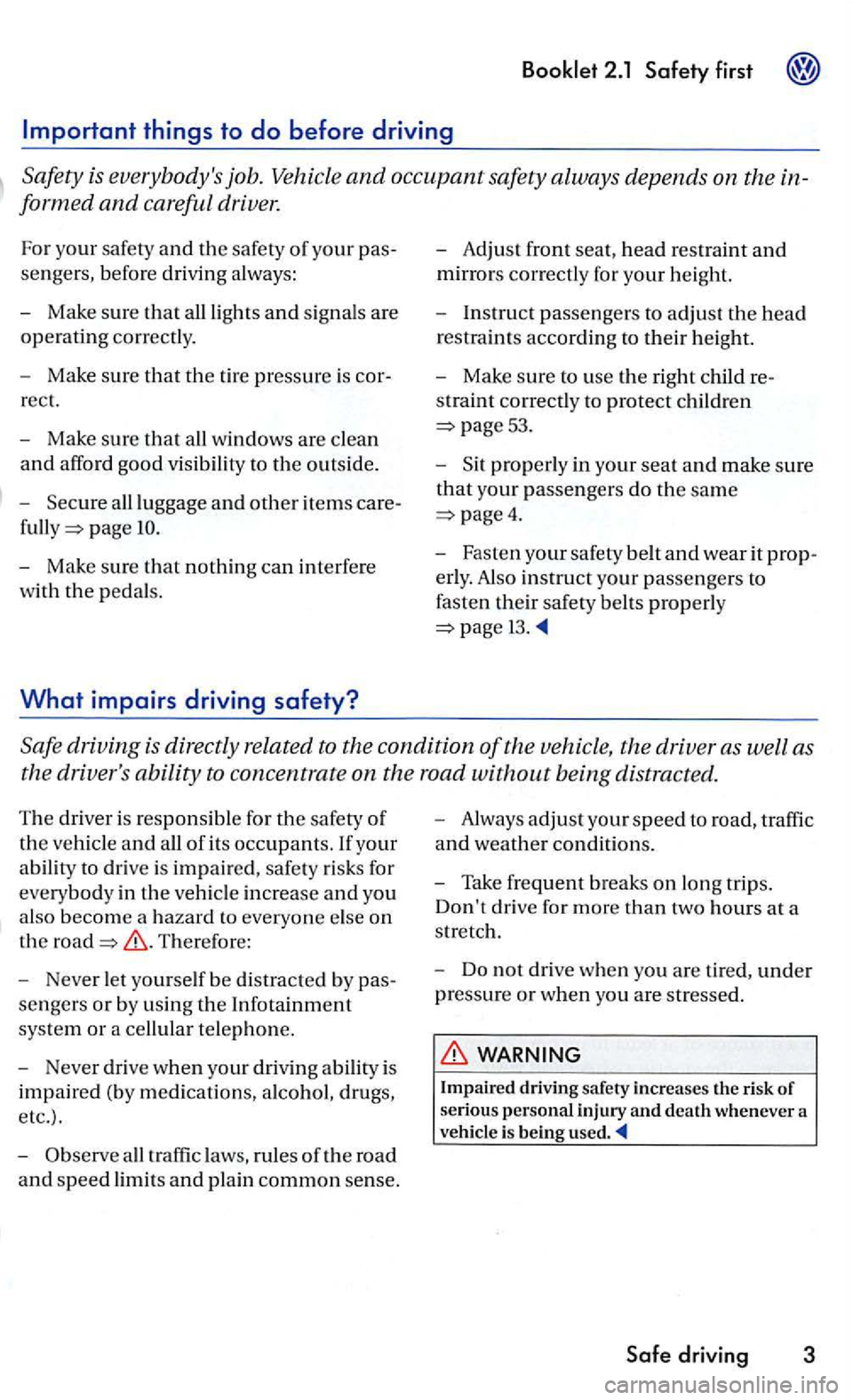
driver.
For your safety and the safety of your pas
sengers, before driving always:
- Make sure
that all lights and signals are
operating corr ect ly.
- Make su re
that the tire pres sure is cor
r
ect.
- Make sure that all windows are clean
and afford good visibility to the outside .
- Secure all luggage and
other items care
page
re
stra int correctly to protect children
53.
- S it properly in your seat and make sure
that your passengers do the same
4.
- Fasten your safety belt and wear it prop
erly. Also instruct your passenge rs to
fasten their safety belts properly
Safe driving is directly related to the condition of the vehicle, the driver as well as
the driver' s ability to concentra te on the road without being distracted.
The driver is responsible for the safety of
the vehi cle and all of its occupants. If your
ability to drive is impa ir ed, safety risks for
everybody in
the vehicle in crease and you
a lso becom e a hazard to everyo ne else
on
the There fo re:
- Never let yourse lf be di stracted by pas
sengers
or by using the Infotainm ent
syste m or a cellular tel ephone.
- Never drive w
hen your driving ability is
impa ired (by medication s, alco hol,
drugs,
etc.) .
- Observe a
ll traffic laws, rules of th e road
and speed limit s and plain common sense. -
Alway s
adjust you r speed to road, traffic
a
nd weathe r conditions.
- Take frequen t breaks on long trip
s.
Don't drive for more than two hours at a
s tretch.
-
Do n ot drive when you are tir ed, unde r
pressure
or when you are stresse d.
WARNING
Impaired driving safety increases the risk of serious personal injury and death whenever a
vehicle is being used
Page 93 of 444
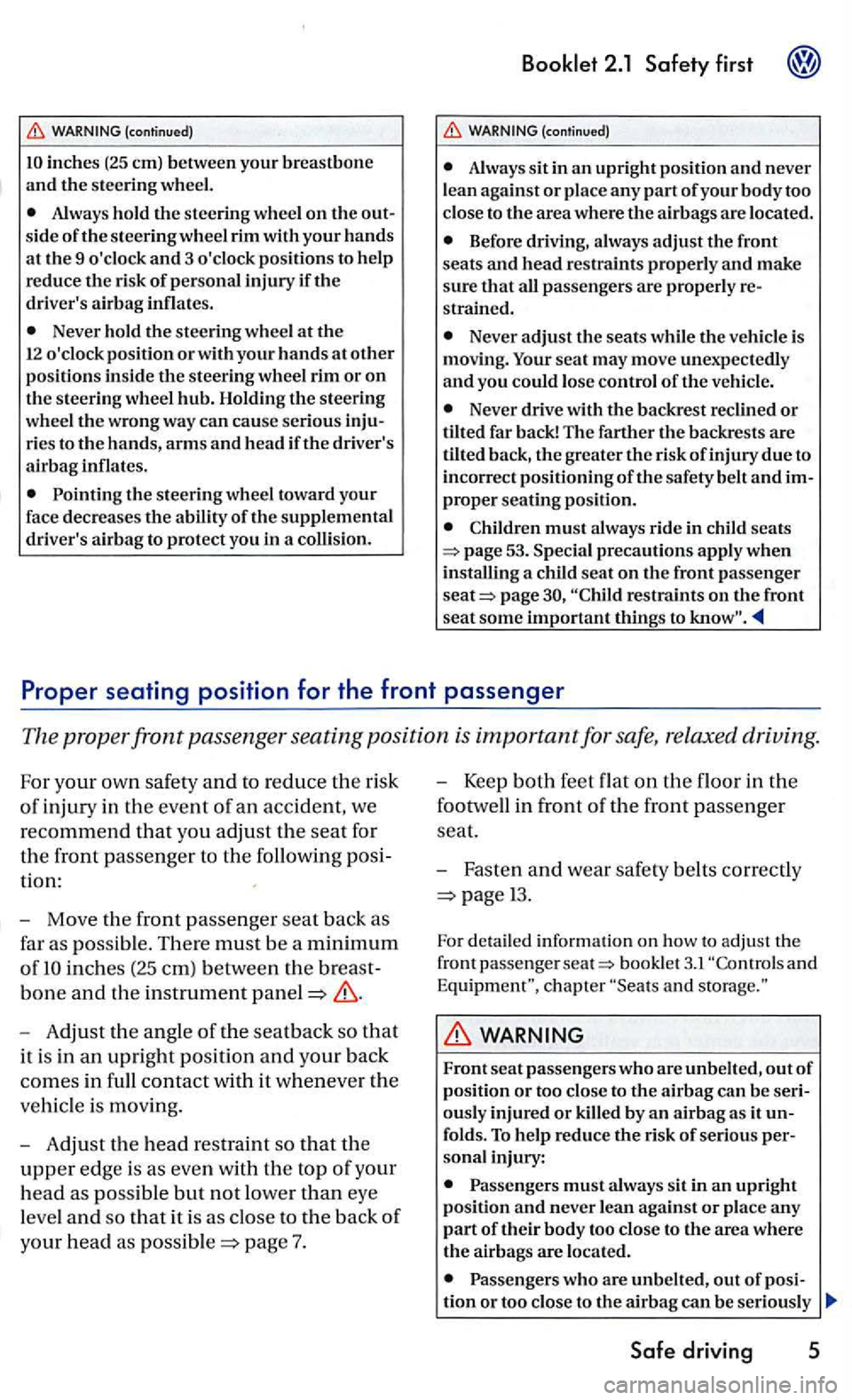
inches (25 em) between your breastbone and the steering wheel.
Always hold the s teering wheel on the
Never hold the steering wheel at the 12 o'clock position or with your hands at other positions inside the steering wheel rim or on the steering wheel hub. Holding the steering
wheel the wrong way can cause serious
2.1 Safety first
(continued)
Always sit in an upright posit i on and never lean against or place any part of your body too
close to the area where the airbags are located.
strained.
Never adjust the seats the vehicl e is mov ing. Your seat may move unexpecte dly and yo u could lose control of the vehicle.
Never drive wit11 the backrest reclined or tilted far back! The fart her t11e backrests are tilted back, the greater the risk of injury due to
incorrect positionin g ofthe safety belt and
Children must always ride in child seats
page restraints on t11e front seat some important things to
Move the front passenger seat back as
far as possible. There must be a minimum
of
Adjust th e angle of the seat back so that
it is in an upright position and your back
comes in full contact with it whenever the
veh icle is moving.
Adjust the head restra int so that the
upper edge is as eve n with the top of your
h
ead as poss ible but not lower than eye
leve l
and so that it is as close to the back of
your head as
Keep both feet flat on the floor in the
footwell in fron t
of the front passenger
seat.
Fasten and wea r safety belt s co rrectly
13.
For detail ed inform ation on how to adju st the
front passenger bookl et 3.1 and s torage.""
WARNING
Front seat passengers who are unbelted, out of posit ion or too close to the airbag can be
risk of serious
Passengers must always sit in an upright position and nev er lean against or place any part of their body too clos e to the area where the airbags are located.
Passengers who are u nbelted, out
Safe driving 5
Page 94 of 444
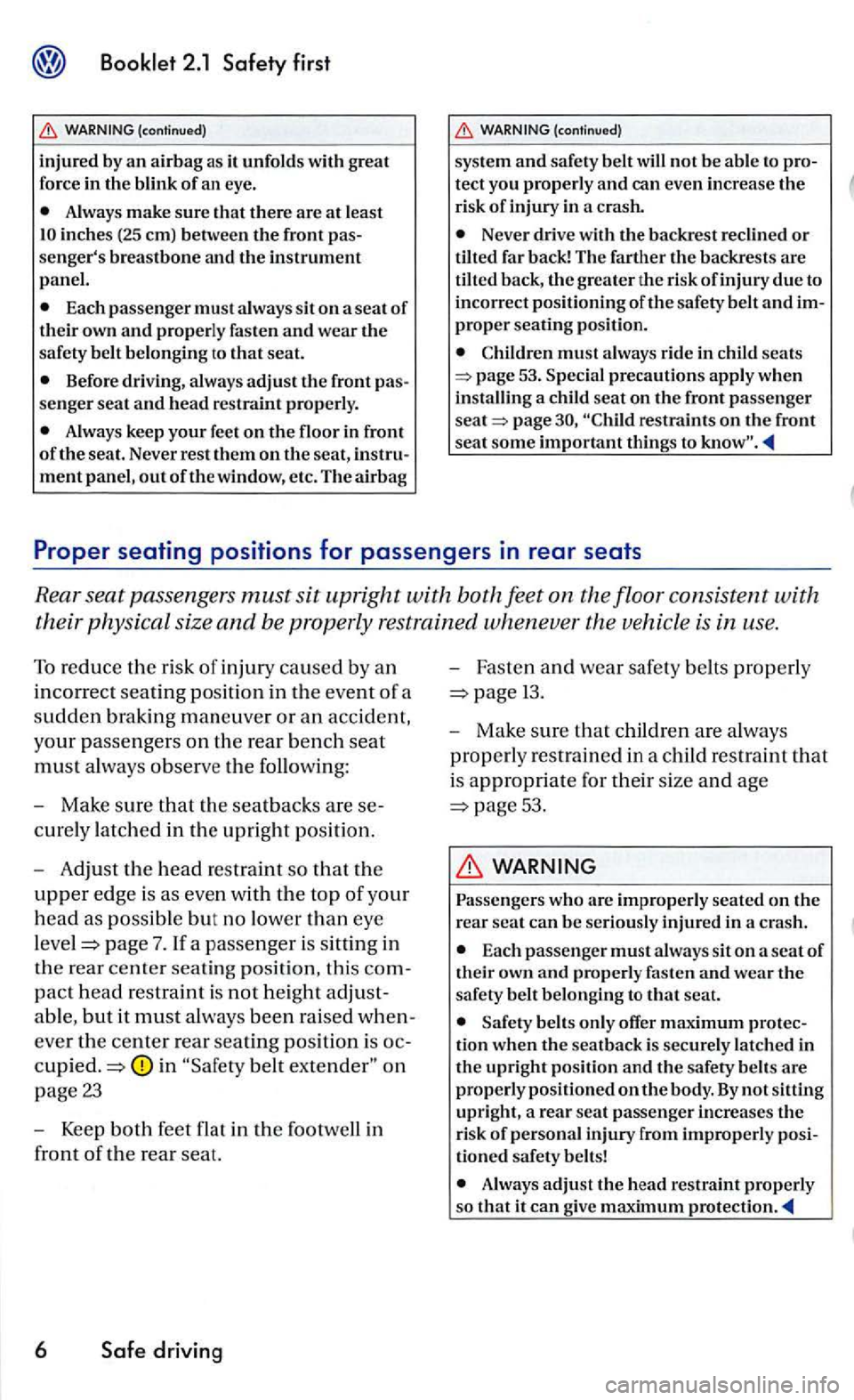
Always make sure that there are at least
Each passenger must always sit on a seat of their own and properly fasten and wear the safety belt be longing to that seat.
Before driving , always adjust the front senger seat and head re straint properly.
Alway s keep your feet on the floor in front of the seat. Never rest them on the seat, ment panel, out of the window, etc. The airbag
tect you properly and can even increa se th e
risk of injury in a crash.
Neve r drive with the backre st recl ined or tilted far back! The farth er the b ackrests are
tilted back, the greater the risk ofinjury due to
in correct positioning of the safety belt and
must always ride in seats 53. a child seat on the front passenger page
Mak e sure that the seatback s are
curel y lat ch ed in the upright position.
A djust th e head restraint so that the
upper edge is as even with the top of your
head as possible but no lower than eye
pag e 7. If a passe nger is s ittin g in
the rear center seating pos ition, this
pac t h ead restra int is not h eight
a ble , but it must always bee n rais ed
eve r the center rear seating posit ion is
belt on
page 23
Keep both feet flat in the footwell in
front
of the rear seat.
6 Safe driving
Fasten and wear safe ty belt s properly
13.
Make sure that children are always
prop e
rly restra in ed in a child re str aint that
is appropriate for thei r size and age
5 3 .
WARNING
Pas sengers who are improperly seated on the rear seat can be se riou sly injure d in a crash.
Each passen ge r must always sit on a seat of th eir own and properly fasten and wear the safety belt belonging to that seat.
belt s only offer maximum tion when the seat back is securely latched in
th e upright po siti on and the safety belts are
properly positioned on the body. By not sitting
upright , a re ar seat pass enger increases the risk of personal injury from improperl y
Always adjust the head restraint properly so that it can give maximum
Page 96 of 444
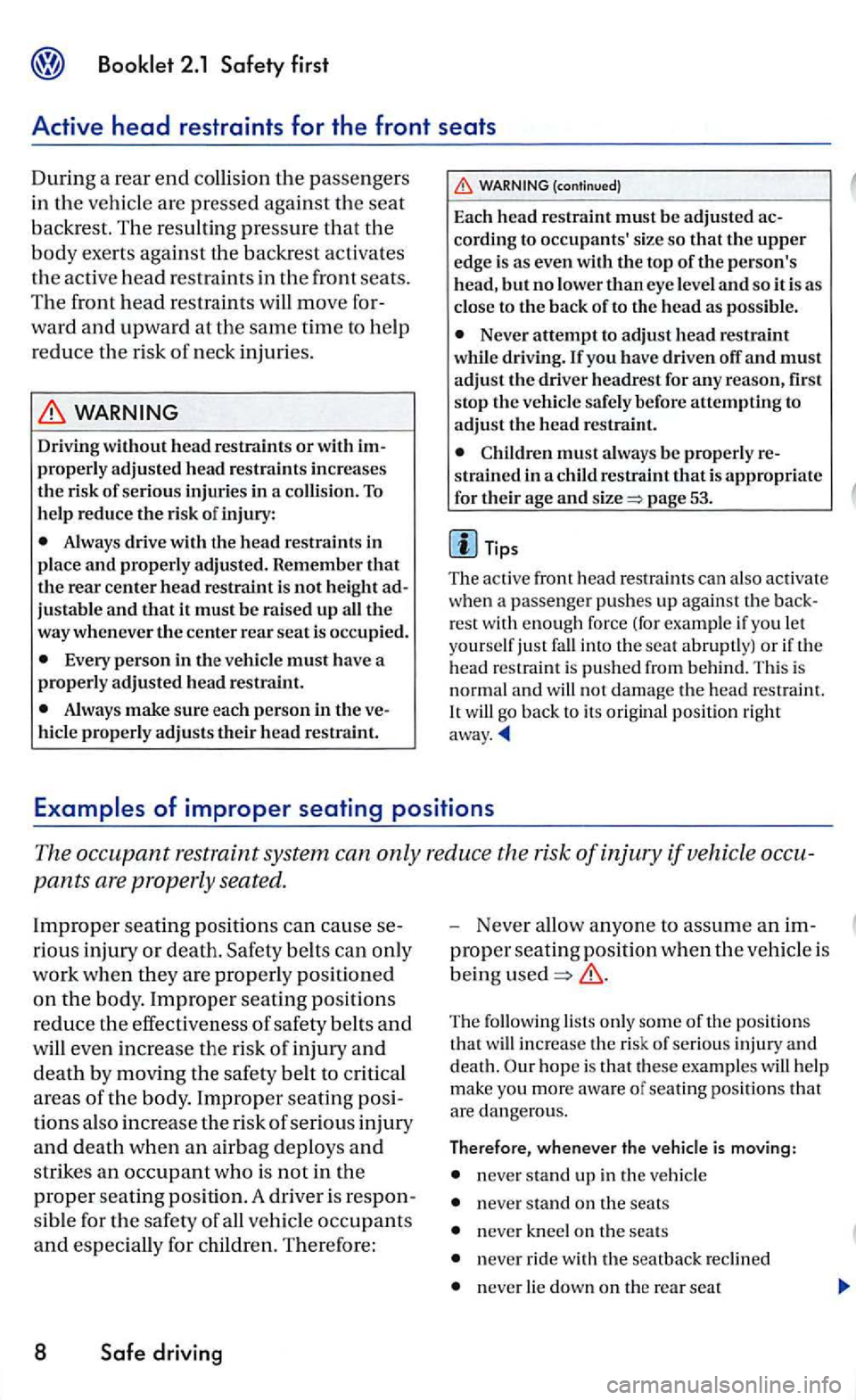
WARNING
Driving head restraint s or with im
properly adjusted head restraints increases
t h e risk of seriou s injuries in a co llision.
To help reduce the risk of injury:
Always drive with the head restraints in
place and properly adjusted. Remember that the rear center head restraint is not height ad
justable and that it must be rai sed up all the way whenever the center rear seat is occupied.
Every person in the vehicl e must have a
properly adjusted head restraint.
Always make sure each person in th e ve
hicle properly adjusts their head restraint.
Neve r attempt to adjust head restraint while driving. If you have driven off and must
adju st the driver headres t for any reason, first
stop the vehicl e sa fely before attempting to adjust th e head restraint.
Childre n must always be properly re
stra ined in a child restraint that is appropriate
for their age and page 53.
Tips
The active front hea d restr aint s ca n al so activate
w he n a passenge r pushe s up again st the backrest with enou gh force (for exampl e if yo u let
yourse lf ju st fall into the seat abruptly) or if th e
h ead restraint is pu shed from behind . Th is is
no rmal and
will not damage the he ad rest ra int. It will go back to it s origina l posit ion right
The followin g lists only some of th e pos ition s
that will increase the risk of seriou s injury and
death.
n eve r stand up in the vehicl e
neve r stand on th e sea ts
n eve r knee l on the seat s
neve r lie do wn on th e rear seat